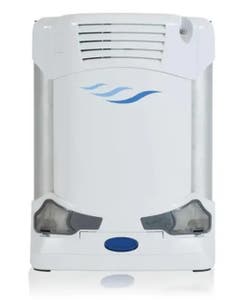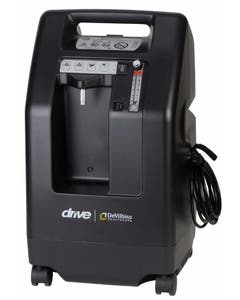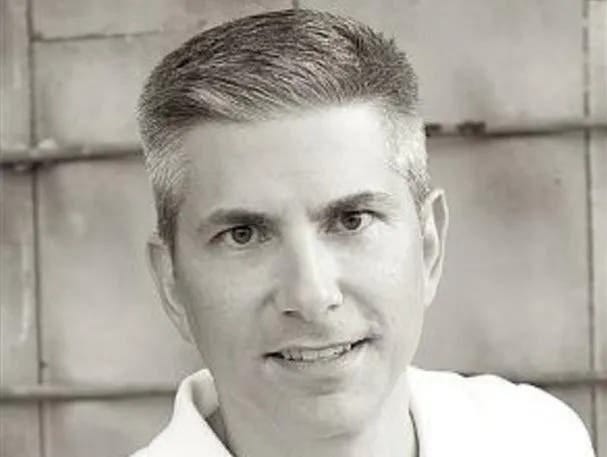Do you have low levels of oxygen in your blood due to respiratory problems, such as COPD, asthma, sleep apnea, cystic fibrosis, or lung disease? If so, your doctor may recommend the use of supplemental oxygen. In the past, your choices of oxygen devices were bulky tanks or cylinders that limited mobility and could even be dangerous. Fortunately, oxygen therapy technology has come a long way. Those who are in need of added oxygen can now choose between multiple home or portable oxygen concentrator options. Here, we provide an overview of how oxygen concentrators work and help you choose the best machine to fit your needs.
What is an oxygen concentrator?
An oxygen concentrator device uses a battery or plugs into an outlet to receive, purify, and distribute air for those who have a low level of oxygen in their blood. These devices are lighter and less bulky than traditional oxygen tanks. They can lead to a more active lifestyle for those who have additional oxygen needs.
How does an oxygen concentrator work?
Normal air comprises 80% nitrogen and 20% oxygen. This is not an issue for people who have normal levels of oxygen in their blood. However, some individuals with low levels struggle with converting normal air into the oxygen their bodies need. An oxygen concentrator takes regular air and purifies it to 90-95% oxygen. To do this, the concentrator uses a compressor that moves air into sieve bed filters to remove the nitrogen. It then distributes the purified oxygen through hoses inserted into the nostrils. The nitrogen is later released back into the air.
There are two different types of oxygen concentrators: home and portable. These machines differ in size, weight, flow, power, and capacity.
How do home oxygen concentrators work?
Home oxygen concentrators are powered through a wall outlet and are intended for stationary therapy. All these machines are in continuous flow mode and deliver a constant rate of oxygen, regardless of inhalation or exhalation. Home oxygen concentrators can deliver anywhere between 1-10 liters per minute of oxygen, based on your prescription. As a result, these machines are heavier. They typically weigh between 40-60 lbs, and are often on wheels to easily be moved from one room to another.
When making a purchase, it is important to compare several factors including liter flow, weight, noise, power usage, and altitude.
Our recommendations:
Philips Respironics EverFlo Oxygen Concentrator with OPI
This is the first ultra-quiet concentrator at an affordable price. Weighing 31 lbs, the EverFLo Q is a small, lightweight, and low maintenance option. This unit delivers 0.5-5 liters per minute of oxygen at a lower power consumption of only 350 watts. It can be used up to 7500 ft altitude and comes with a 3-year warranty.
Inogen At Home
The energy-efficient Inogen At Home is one of the lightest and quietest home oxygen concentrators on the market today. It runs at very low power consumption levels, thus saving you money! The device weighs only 18 lbs and delivers 1-5 liters per minute of oxygen. It can be used at an altitude of up to 8000 ft. The machine also comes with a 3-year warranty.
How do portable oxygen concentrators work?
Portable oxygen concentrators provide supplemental oxygen in various different settings, whether at home or on the go. There are two types of portable oxygen concentrators: continuous flow and pulse dose.
Continuous Flow Portable Oxygen Concentrators
Continuous flow oxygen concentrators deliver oxygen at a constant rate without paying attention to inhalation or exhalation. This mode allows oxygen to also be hooked up to PAP machine. However, since oxygen is constant, the device uses more battery power. These machines are usually bigger in size and can supply higher oxygen demands. Note: Not all portable oxygen concentrators have a continuous flow mode.
Our Recommendations:
Philips Respironics SimplyGo Portable Oxygen Concentrator
Known for its lightweight and compact battery, SimplyGo makes daily use simple with no external battery belts, connectors, or inaccessible internal batteries. Instead, the 10-lb device offers both continuous flow or pulse dose settings. The machine passed testing in various extreme conditions including impact, vibrations, and temperatures. The FAA approves this device for use in flight.
DeVilbiss iGo Portable Oxygen Concentrator with Wheeled Case
Weighing 20 lbs, this oxygen system delivers both continuous flow and pulse dose options. Use either a rechargeable battery or AC/DC power source. Plus, the device will automatically switch to battery if power is interrupted. Finally, a built-in oxygen sensing device guarantees that oxygen is delivered accurately. The FAA approves this device for use in-flight.
Pulse Dose Portable Oxygen Concentrators
Pulse dose oxygen concentrators deliver oxygen only when the patient inhales and stops when they exhale. This reduces battery usage as compared to continuous flow mode and allows for smaller device sizes. However, your prescription will need to specify a pulse dose settings.
Our Recommendation:
Inogen One G4 Portable Concentrator
The smallest, lightest, and quietest unit of its type, the Inogen G4 weighs only 2.8 lbs and uses a single battery system. The device uses either a charged battery or plugs into an AC/DC outlet. The machine offers pulse dose settings 1-3 but does not have a continuous flow mode option.
Philips Respironics SimplyGo Mini Portable Oxygen Concentrator
The newest oxygen concentrator from Philips, this machine offers two battery options. With the standard battery that lasts 4.5 hours on 2 pulse setting, the device weighs 5 lbs. With the extended battery that lasts up to 9 hours on 2 pulse setting, the device weighs 6 lbs. The machine is lightweight, easy to use, and FAA-approved.
Which oxygen concentrator is best for you?
Oxygen concentrators are an excellent alternative to traditional oxygen tanks or cylinders. They can help those with low oxygen flow to live a more active lifestyle. To get started, your doctor will need to prescribe either a pulse dose or continuous flow setting. Our team is available by phone or email to help answer your questions or offer suggestions as to which device best fits your needs.
Do you have low levels of oxygen in your blood due to respiratory problems, such as COPD, asthma, sleep apnea, cystic fibrosis, or lung disease? If so, your doctor may recommend the use of supplemental oxygen. In the past, your choices of oxygen devices were bulky tanks or cylinders that limited mobility and could even be dangerous. Fortunately, oxygen therapy technology has come a long way. Those who are in need of added oxygen can now choose between multiple home or portable oxygen concentrator options. Here, we provide an overview of how oxygen concentrators work and help you choose the best machine to fit your needs.


What is an Oxygen Concentrator?
An oxygen concentrator device uses a battery or plugs into an outlet to receive, purify, and distribute air for those who have a low level of oxygen in their blood. These devices are lighter and less bulky than traditional oxygen tanks. They can lead to a more active lifestyle for those who have additional oxygen needs.
How Does an Oxygen Concentrator Work?
Normal air comprises 80% nitrogen and 20% oxygen. This is not an issue for people who have normal levels of oxygen in their blood. However, some individuals with low levels struggle with converting normal air into the oxygen their bodies need. An oxygen concentrator takes regular air and purifies it to 90-95% oxygen. To do this, the concentrator uses a compressor that moves air into sieve bed filters to remove the nitrogen. It then distributes the purified oxygen through hoses inserted into the nostrils. The nitrogen is later released back into the air.
There are two different types of oxygen concentrators: home and portable. These machines differ in size, weight, flow, power, and capacity.
What are the Main Components of an Oxygen Concentrator?
Oxygen concentrators are designed with four primary components:
- Compressor: draws in ambient air.
- Inlet air filter: filters out particulate matter from entering the oxygen flow.
- Sieve beds: uses Zeolite to remove nitrogen from the ambient air to transform it into pure oxygen.
- Product tank: contains the pure oxygen to deliver through the hose and nasal cannula to the patient.
How Do Home Oxygen Concentrators Work?
Home oxygen concentrators are powered through a wall outlet and are intended for stationary therapy. All these machines are in continuous flow mode and deliver a constant rate of oxygen, regardless of inhalation or exhalation. Home oxygen concentrators can deliver anywhere between 1-10 liters per minute of oxygen, based on your prescription. As a result, these machines are heavier. They typically weigh between 40-60 lbs and are often on wheels to easily be moved from one room to another.
When making a purchase, it is important to compare several factors including liter flow, weight, noise, power usage, and altitude.
Our Recommendation: Inogen at Home
The energy-efficient Inogen At Home is one of the lightest and quietest home oxygen concentrators on the market today. It runs at very low power consumption levels, thus saving you money! The device weighs only 18 lbs and delivers 1-5 liters per minute of oxygen. It can be used at an altitude of up to 8000 ft. The machine also comes with a 3-year warranty.
How Do Portable Oxygen Concentrators Work?
Portable oxygen concentrators provide supplemental oxygen in various settings, whether at home or on the go. There are two types of portable oxygen concentrators: continuous flow and pulse dose.
Continuous Flow Portable Oxygen Concentrators: Portable oxygen concentrators provide supplemental oxygen in various settings, whether at home or on the go. There are two types of portable oxygen concentrators: continuous flow and pulse dose.
Pulse Dose Portable Oxygen Concentrators: Pulse dose oxygen concentrators deliver oxygen only when the patient inhales and stops when they exhale. This reduces battery usage as compared to continuous flow mode and allows for smaller device sizes. However, your prescription will need to specify pulse dose settings.
Our Recommendation: Inogen One G4
The smallest, lightest, and quietest unit of its type, the Inogen G4 weighs only 2.8 lbs and uses a single battery system. The device uses either a charged battery or plugs into an AC/DC outlet. The machine offers pulse dose settings 1-3 but does not have a continuous flow mode option.
Key Differences Between Home and Portable Oxygen Concentrators
Flow Type: Continuous vs. Pulse Dose
Continuous flow delivers oxygen continuously which provides patients with severe respiratory conditions with assistance breathing on a consistent basis. Pulse dose delivers oxygen based on the inhalation and exhalation of the patient to support breathing as needed.
Power Source and Portability
Continuous flow delivers oxygen continuously which provides patients with severe respiratory conditions with assistance breathing on a consistent basis. Pulse dose delivers oxygen based on the inhalation and exhalation of the patient to support breathing as needed.
Size, Weight, and Noise Level
Most home oxygen concentrators tend to be larger and heavier but have casters for easier mobility around the home. Portable oxygen concentrators are lighter and smaller to make them easier to carry and pack. Noise level can vary based on models regardless of whether they are home units or portable units.
Who Benefits from Using an Oxygen Concentrator?


Common Conditions Requiring Oxygen Therapy
Any respiratory condition that depends on breathing assistance can make an oxygen concentrator useful to a patient. Many conditions can range in severity and include COPD, emphysema, and severe asthma.
Elderly and Chronic Respiratory Patients
Older patients may have compromised lung function with age. Some chronic patients with severe respiratory illness may need oxygen to support normal breathing. Both types of patients can use an oxygen concentrator to maintain normal, healthier breathing which can improve quality of life.
Active Individuals and Portable Solutions
Many patients managing respiratory illness can still be active in their lives. Portable oxygen concentrators give them the freedom to shop, travel and conduct an active lifestyle without being hindered by their respiratory condition.
How Oxygen Concentrators are Different from Oxygen Tanks
Oxygen concentrators can offer many benefits compared to oxygen tanks. Oxygen concentrators use the ambient air to generate pure oxygen so the oxygen supply never runs out. Oxygen tanks contain pure oxygen which eventually needs to be replenished.
Oxygen tanks are more flammable making them dangerous to keep in the house and can be bulkier and heavier than most oxygen concentrators. Learn more about the difference between the two types of oxygen therapy.
Maintenance and Care for Oxygen Concentrators
Cleaning and Changing the Filters: Use your oxygen concentrator manufacturer's recommendations for filter cleaning and changing. Follow these steps to maintain your oxygen concentrator filters.
- Clean filters with warm water on a regular schedule.
- Let them thoroughly dry before replacing them in your machine.
- Replace filters when they appear damaged or worn.
Battery Care for Portable Concentrators: For portable oxygen concentrators maintaining your batteries ensures lasting performance while away from home.
- Never let your batteries completely drain. Recharge your battery when it reaches around 20-30% remaining power to prolong its life.
- Make sure your batteries are fully charged before setting out from home with your portable oxygen concentrator.
- Know how long your batteries last so you know how long your portable oxygen concentrator will stay charged.
- Bring along a charger to recharge as needed.
When to Service or Replace Parts: For portable oxygen concentrators maintaining your batteries ensures lasting performance while away from home.
- Never let your batteries completely drain. Recharge your battery when it reaches around 20-30% remaining power to prolong its life.
- Make sure your batteries are fully charged before setting out from home with your portable oxygen concentrator.
- Know how long your batteries last so you know how long your portable oxygen concentrator will stay charged.
- Bring along a charger to recharge as needed.
Which Oxygen Concentrator is Best For You?
Oxygen concentrators are an excellent alternative to traditional oxygen tanks or cylinders. They can help those with low oxygen flow to live a more active lifestyle. To get started, your doctor will need to prescribe either a pulse dose or continuous flow setting. Our team is available by phone or email to help answer your questions or offer suggestions as to which device best fits your needs.
Where Can I Buy Affordable, Top-Quality Oxygen Concentrators?
When you need oxygen therapy, you can consult with one of the leading retailers in the oxygen equipment industry. The Oxygen Concentrator Supplies Shop offers affordable equipment and accessories and can assist you in your purchase based on your prescription. We will help you find exactly what you need for your oxygen therapy all while making your shopping experience easy and stress-free. Call us at 888-941-1688 today!











